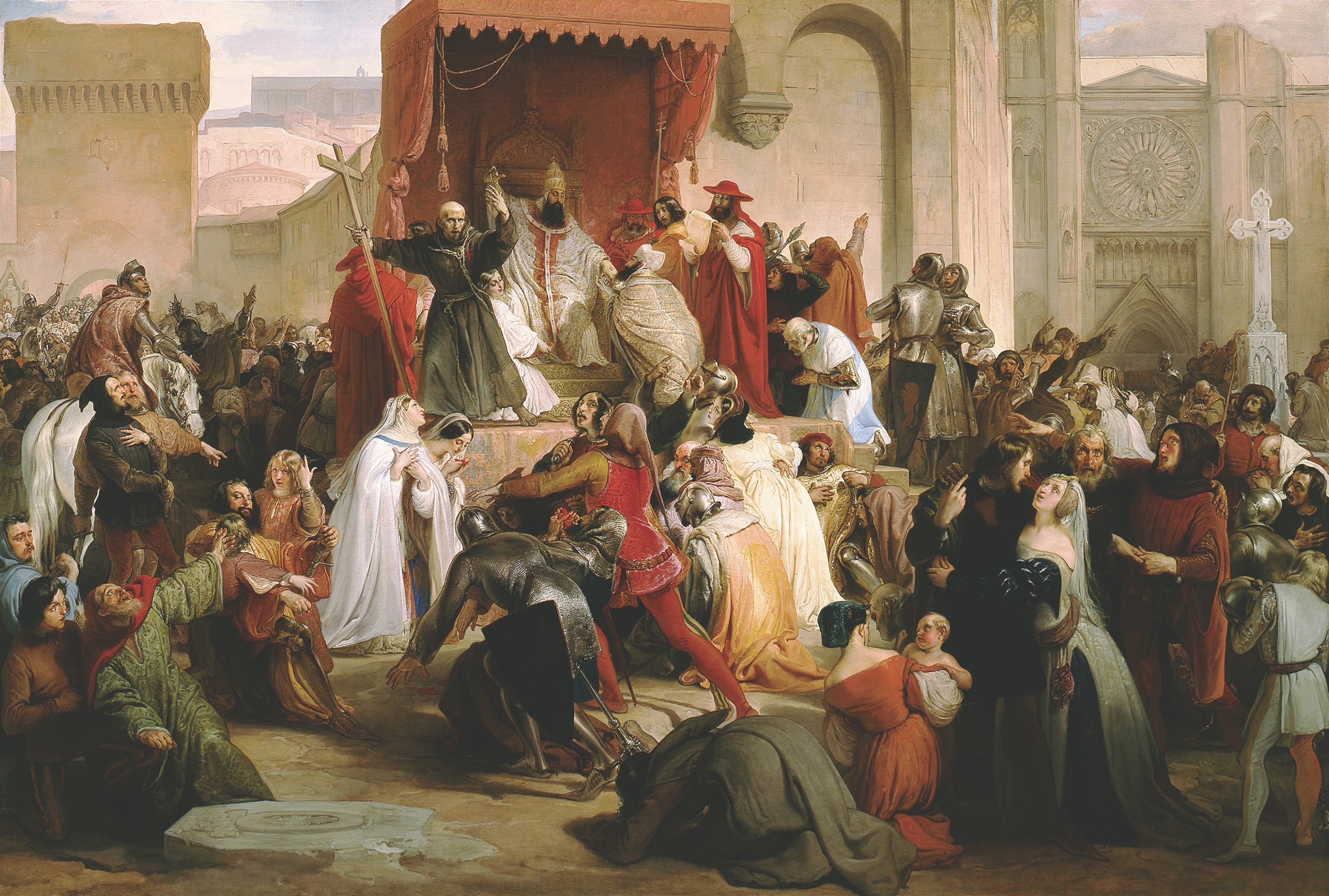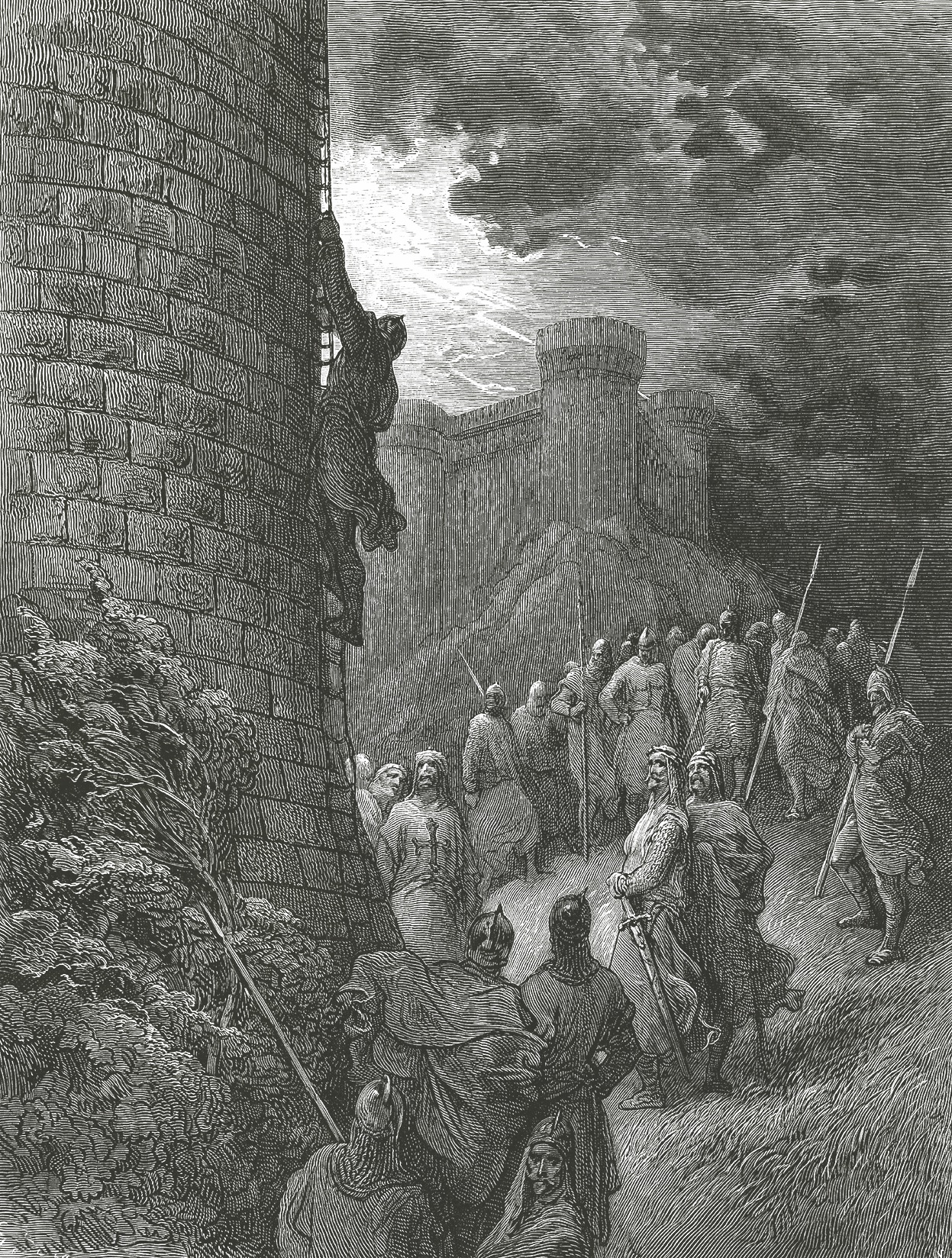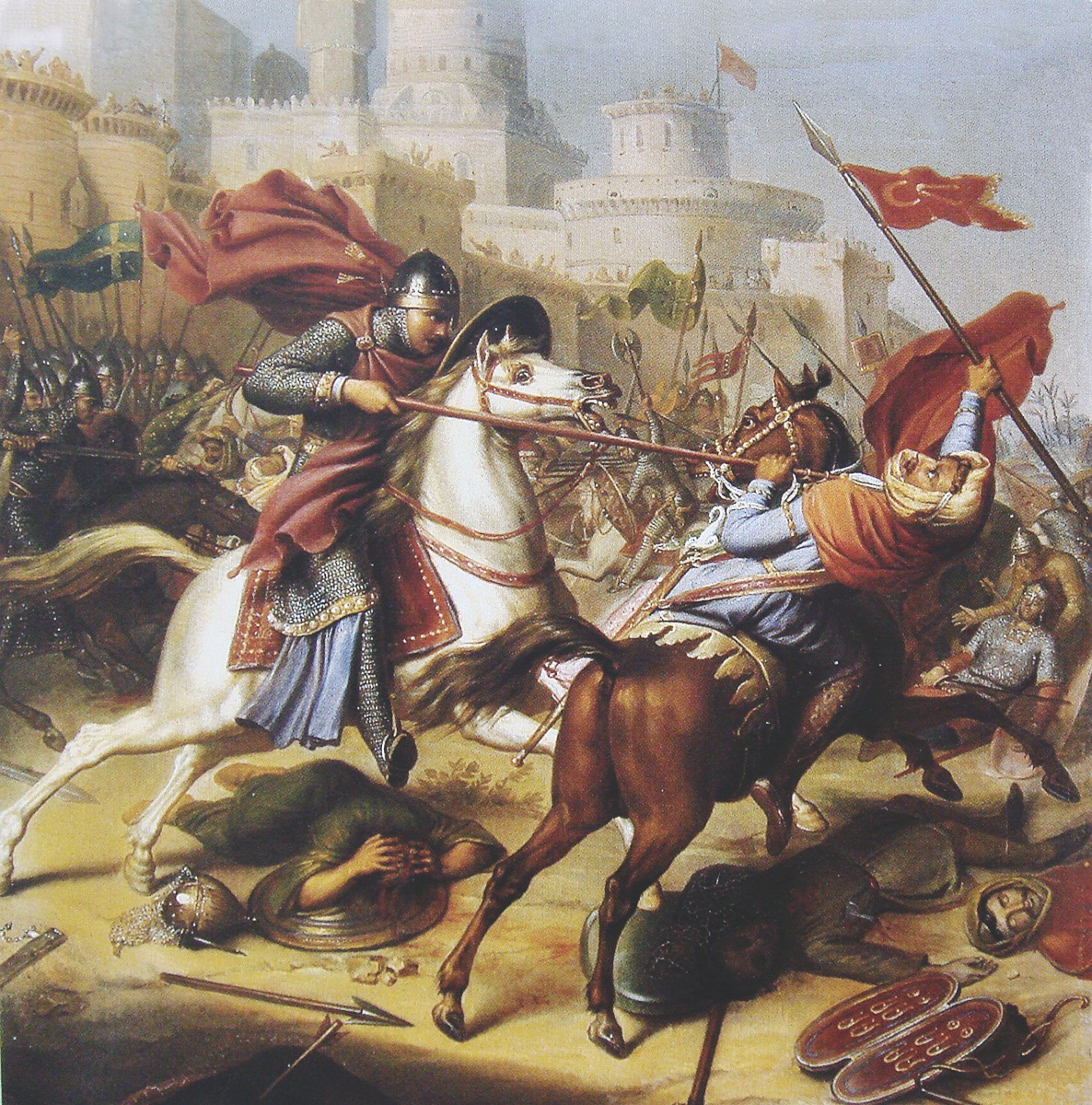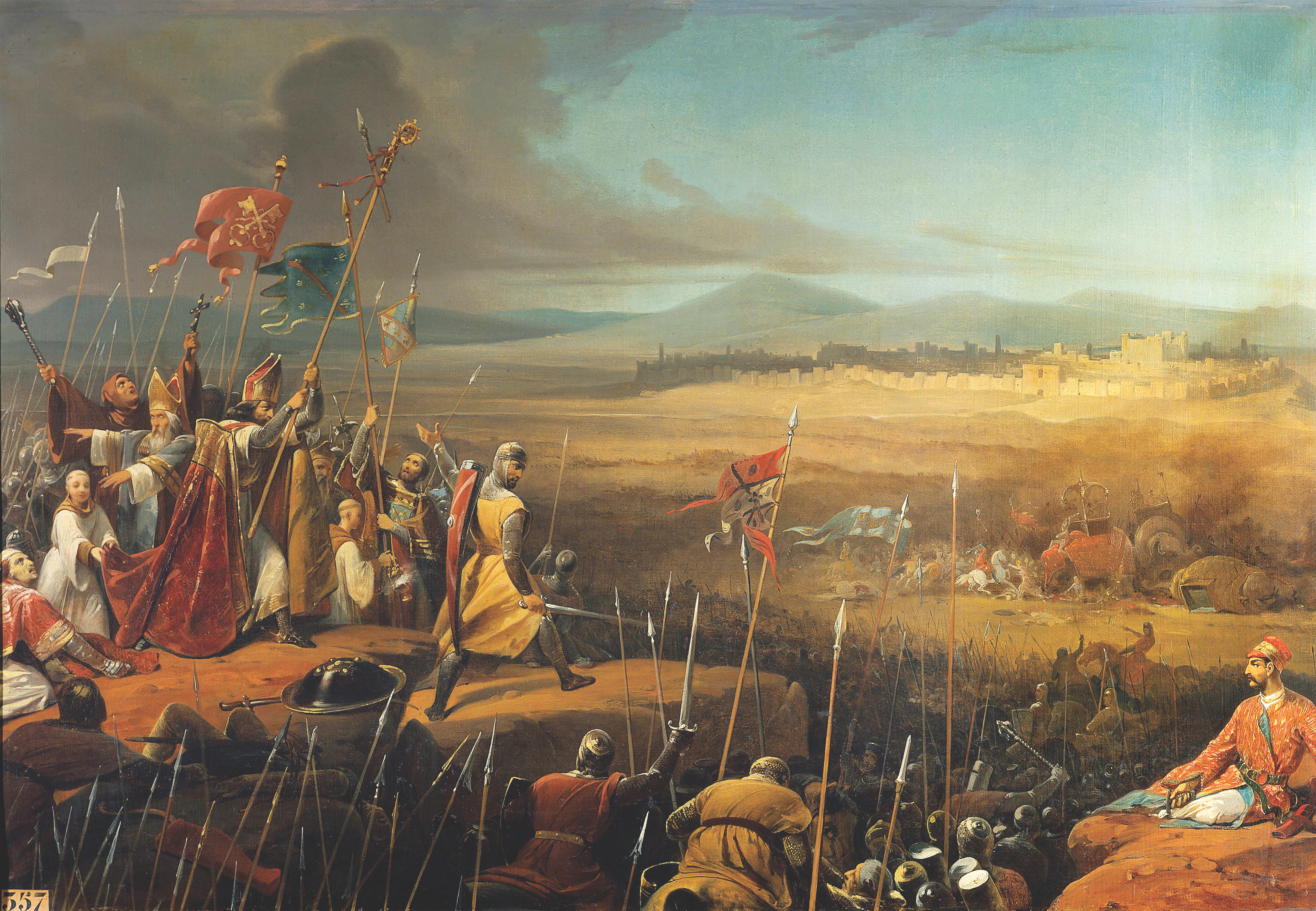As the Bridge Gate of Antioch swung open on June 28, 1098, arrows rained down on the grimly determined Christian column advancing out of the city. These soldiers of the First Crusade had besieged Muslim-held Antioch for more than seven months before finally taking the city, only to be immediately besieged themselves by a massive Muslim army. Within a month, facing defeat through starvation, their leaders had decided to venture outside the walls and do battle. Conquer or die, the coming confrontation would mark the final act in the saga of the conquest of Antioch.
Following a series of disastrous reversals in Asia Minor (present-day eastern and central Turkey) between 1091 and 1095, the Byzantine empire faced an existential threat: The Seljuk Turks, recent converts to Islam, had advanced to within 50 miles of the Byzantine capital of Constantinople. Emperor Alexius I Comnenus sent a delegation to Pope Urban II in Rome, begging for military support against the Turks. Fortunately for Alexius, Urban and the knights of Western Europe were able and willing to respond. On Nov. 27, 1095, Urban appeared at Clermont in southern France and called on the gathered knights to liberate the Christians of the East and the Holy City of Jerusalem from the Seljuk scourge.
The great army that responded to Urban’s call had coalesced in Constantinople by the spring of 1097. It was organized in four “national” contingents, each under the leadership of its respective lords. From northern and central France came Duke Robert of Normandy, son of William the Conqueror; Count Stephen of Blois and Chartres, one of the Conqueror’s sons-in-law; Count Hugh of Vermandois, younger brother of King Philip of France; and Count Robert of Flanders. From the northern border area between France and Germany came Godfrey of Bouillon, Duke of Lower Lorraine.
From southern France came Raymond of Saint-Gilles, Count of Toulouse, who, being in his mid-50s, was the oldest of the commanders, as well as the wealthiest. Raymond was the first great lord to “take the cross,” and he shared the leadership of his contingent, probably the largest, with Bishop Adhemar of Le Puy, Pope Urban’s representative on the crusade.
Finally, from Sicily and southern Italy came Normans under Prince Bohemond of Taranto, eldest son of Robert Guiscard, the Norman conqueror of southern Italy and Sicily. Bohemond’s exceptional military ability and resourcefulness would prove invaluable to the Crusaders.
Although the precise number of people who marched in the Crusader host is uncertain, 43,000 is a reasonable estimate. Of that number some 34,500 were warriors (30,000 foot-soldiers and 4,500 mounted knights). The remaining 8,500 were noncombatants—women, children, clergy and elderly male pilgrims.
The Crusader army arrived outside the walls of Antioch on October 21. The city lay little more than a dozen miles inland east of the Mediterranean Sea in northern Syria (present-day south central Turkey). By the time of the First Crusade the city had been in existence some 1,400 years, having been founded in 300 bc by Seleucus I Nicator, among the Macedonian successors to rule Alexander the Great’s fragmented empire. Antioch was especially venerated by Christians, as the first church for gentiles was founded in the city, and it was there disciples of Jesus were first called Christians.

The Eastern Roman Emperor Justinian I had ordered construction of Antioch’s immense walls in the sixth century, and they were repaired in the 10th century by Byzantine engineers. In the north the walls ran along marshy ground adjacent to the south bank of the Orontes River. To the east and west the walls ascended the slopes of Mount Silpius till converging on a citadel at its summit, some 1,440 feet above the city. The Turks had only been able to take Antioch in 1085 because a traitor had opened a gate to them.
The Crusaders held no illusions about taking the city by direct assault. They instead tried to blockade as much of it as possible without dispersing their forces too thinly, hoping the defenders would ultimately capitulate or be betrayed. For his part, Yaghi-Siyan, the governor of Antioch for the past decade, settled for ambushing enemy foraging parties while awaiting a Muslim relief army.
The Christians initially had little trouble feeding themselves, as food was plentiful. By Christmas, however, they had exhausted staples in the valley. On New Year’s Eve a large foraging party under Bohemond and Robert of Flanders found itself in a pitched battle with a Muslim relief army from Damascus. Though the Crusaders prevailed, they returned empty-handed, leaving the men in camp on starvation rations through January 1098. One of every seven Crusaders starved to death, their horses dying in even greater numbers. To escape the misery, increasing numbers of men deserted the siege.
The situation looked grim in early February when the Crusaders learned a large Muslim relief army was advancing west from Aleppo. Against the 12,000 approaching horse archers the Christian army could muster only 700 mounted knights, some of whom had been reduced to riding pack animals or oxen due to the scarcity of horses.
Given his record of military prowess, Bohemond was appointed commander of the sortie. Leaving the infantry to guard camp, he led out the knights to ambush the approaching Turkish army. Bohemond divided his men into six mounted squadrons. Five would charge the enemy, while Bohemond held the sixth in reserve, waiting for the decisive moment when its charge would take the greatest toll. Concealing themselves behind a hill on the road from Aleppo, the Christian horsemen awaited their quarry.
On the morning of February 9 the Muslim relief army approached slowly from the east, two squadrons of cavalry in the lead. As the enemy horsemen neared the point of ambush, Bohemond’s knights charged out with couched lances to strike the Turkish vanguard in the flank, throwing them back in disorder into the main force.
Adept at close-quarters combat, the Crusaders pressed their advantage, but the Turks’ numbers soon stabilized their lines. At that point, with the battle hanging in the balance, Bohemond’s reserve squadron joined the fray and shattered the Turkish formation. The defeated Turks lost upward of 2,000 men on the field and in the subsequent rout. Bohemond’s victory in the Battle of the Lake reinvigorated the Crusaders, thwarting Muslim hopes to catch and destroy the crusading army outside the walls of Antioch. That said, the victory did nothing tangible to hasten Antioch’s fall, nor did it alleviate the food shortage plaguing the camp.
Early March brought an English fleet laden with food and building materials for the camp. The Crusaders immediately set to work building siege engines and fortifications to complete their encirclement of Antioch. With the city’s major gates blocked, they were once again free to forage and receive supplies.
That effectively turned the tables. As the Muslim garrison’s food supplies began to dwindle, the defenders faced the real prospect of being starved into submission. To dispel any doubts about his own resolve, Yaghi-Siyan ordered the beheading of a captured Crusader who had refused to renounce his faith, then had the remaining Christian prisoners burned alive on a great pyre. In so doing, the governor also hoped to convince his own soldiers they could expect no mercy from the Christian army if it entered the city. Regardless, in late May news reached Antioch that seemed to put a Crusader victory beyond the realm of possibility.
For most of that month Kerbogha—a Turkish general and governor of the city of Mosul—had been besieging the Christian garrison at Edessa, an Armenian city 150 miles to the northeast. Given the distance, Bohemond and the other crusade leaders had not perceived his army as a threat. But then Kerbogha abandoned the siege and began marching on Antioch. Turns out, it had been his target all along. The Turkish general had only attacked Edessa in hopes of removing a potential threat to his lines of communication.

Picking up reinforcements along the march, Kerbogha’s army numbered upward of 40,000 men by the time it arrived outside Antioch. News of its approach dispirited the Crusaders. Were the larger Muslim force to catch them outside the city walls, death seemed a strong possibility. Many fled for their lives. What they couldn’t have known is that Bohemond had entered into negotiations with the commander of three of the city’s defensive towers and a section of adjoining wall. Firuz, an Armenian who had converted to Islam, held a grudge against Yaghi-Siyan, who had punished him for hoarding. Bohemond’s promises of riches in exchange for opening the city gates was icing on the cake.
On June 2 Firuz’s son slipped out of Antioch to inform Bohemond all was ready. The Norman commander then revealed his clandestine communications to the other crusade leaders. In exchange for his efforts, Bohemond also demanded he be declared ruler of Antioch after its capture. Agreeing nearly to a man, the others prepared to storm the gates.
As night fell, a large contingent of Crusaders noisily left camp, leading the city’s defenders to believe they were off to ambush Kerbogha’s army. Under cover of darkness, however, the Crusaders wheeled about and crept up to the southern wall of the city, beneath Firuz’s towers. They split into two strike forces—one commanded by Bohemond, the other jointly by Godfrey and Robert of Flanders. Bohemond’s force would enter the city over Firuz’s section of the wall, while Godfrey and Robert mounted a diversionary attack against the commanding citadel.
Just before dawn on June 3 Bohemond’s knights placed a ladder against one of Firuz’s towers and began scaling the wall unopposed. The ladder broke soon after Bohemond himself had clambered over, but by then the first men into the city had opened a postern gate. As the Crusaders seized other towers, more ladders went up. Finally, besiegers flung open two main gates, and the rest of the Christian army poured into Antioch. By nightfall the only Muslims left alive were besieged in the citadel. As he rode into the surrounding hills in a panic, Yaghi-Siyan was thrown from his horse and promptly beheaded by Armenian peasants.
Antioch belonged to the Crusaders. They had entered just in time. Two days later the vanguard of the Muslim relief army arrived outside the walls.
Kerbogha encamped his main army within a few miles of Antioch, establishing satellite camps for siege operations in the areas previously occupied by the Crusaders. On June 8 his troops also set up an outpost on Mount Silpius. The brutal initial fighting centered on the citadel and along the south wall. The Muslims were severely hampered by the fact only two narrow paths led to or from the citadel. Ultimately abandoning his camp on the mountain, Kerbogha turned his efforts to a close blockade of the city.
While the Crusaders welcomed a respite from combat, they were all too aware Kerbogha’s blockade could be equally deadly, given the dire conditions in Antioch. On entering the city, the Christian troops had discovered, much to their chagrin, that their successful blockade had very thoroughly depleted the food supply.
As morale deteriorated, another batch of Crusaders deserted, among them Bohemond’s brother-in-law. Others failed to perform their duties, instead languishing in the city’s pillaged houses to await the end. Bohemond motivated such despondent souls by setting several homes ablaze and ordering the roused men back onto the walls. Exhibiting none of the lassitude paralyzing the rest of the army, Bohemond energetically organized the defense of the city. Yet it remains debatable whether even his powerful leadership could have led the embattled Crusaders to victory had it not been for the sudden appearance of the supernatural in their midst.
On June 10 a French peasant and reputed Christian seer named Peter Bartholomew came before the crusade’s leaders and made an extraordinary announcement. He claimed St. Andrew had appeared to him in visions, revealing that the head of the lance that had pierced Jesus’ side as he hung on the cross lay concealed beneath the floor of Antioch’s Church of St. Peter. Bartholomew further asserted the saint had assured the Christian army victory if it carried the Holy Lance before it into battle. On June 14 Crusaders dug up the floor of the church but found nothing. At nightfall, however, Bartholomew himself climbed into the diggings with the searchers and soon pointed out the tip of a lance protruding from the side of the trench.
Although the tale of the lance had its share of skeptics—notably Bishop Adhemar and Bohemond—the discovery of the relic had a transcendent impact on the morale of the Christian army, which spoiled for a fight. While the news had bolstered the men’s spirits, however, their commanders understood the importance of proper planning before emerging to fight a conclusive battle. Their first step was to appoint Bohemond overall military commander.
Bohemond’s strategy was dictated by a logistical constraint: Most of the knights lacked horses. Reasonable estimates of the number of animals available to the Crusaders for the final battle range between 200 and 600. Even accepting the higher number, such a small force of mounted knights couldn’t possibly decide the outcome of the forthcoming battle. Thus it fell to the infantry to accomplish what foot soldiers on the battlefields of Western Europe rarely had—to attack and defeat the enemy.
While the number of warriors available to Bohemond is unknown, by that point in the campaign starvation and disease had probably reduced the army to no more than 20,000 men. Bohemond grouped them by “nationality” into four main divisions. The first, which would form the right wing of the Crusader battle line, comprised the northern French and Flemings and northern Normans under Hugh of Vermandois and the two Roberts. The second comprised Godfrey’s troops and would occupy the center. The third, on the left wing, comprised the southern French, led solely by Bishop Adhemar, as Raymond was too ill to fight and elected to remain behind with 200 men to guard the citadel. The fourth comprised the southern Normans under Bohemond, who would again hold his force in reserve, wielding it as a hammer against hard-pressed sections of the line and—when the time came, and with God’s blessing—striking the decisive blow.
On the morning of June 28 the Crusaders gathered just inside the Bridge Gate to prepare for the battle that would either extend or end the First Crusade. Noting the movement, besieged Turks in the citadel flew a black flag to signal Kerbogha of the coming storm.
As the first Crusader column got under way, some priests stood on the ramparts to pray for divine assistance, while others walked among the troops to issue blessings. Raymond of Aguilers, a French chaplain and the official campaign chronicler, had the honor of bearing the Holy Lance. In the vanguard, the northern French marched out with archers and crossbowmen supplied by the other divisions, ready to counter an expected barrage of enemy arrows. That expectation proved well founded, as a force of 2,000 Muslim horse archers promptly unleashed a rain of arrows on Hugh’s troops. Shield-bearing Christian soldiers protected their own archers as the latter returned fire. The Crusaders’ effective volleys of arrows and crossbow bolts found marks among the Turkish horsemen, who soon broke and fled the field.
With the enemy cavalry out of the fight, the first division of Crusader infantry swung to the right, anchored its flank on the river and attacked in line, targeting the Muslim light infantry. Godfrey’s men then rushed out to the left of the first division to join the attack, while Adhemar’s force advanced across the plain to secure the left flank. Muslim cavalry from the satellite camps around the city eagerly rushed to join the battle, but with no clear idea of where to go or what they were supposed to be doing. In the absence of any orders, they swarmed around Adhemar’s troops, unleashing plenty of arrows but failing to engage in close combat and thus prevent the column from forming up on the left flank.
Kerbogha had still not moved out of camp, apparently content to allow the entire Christian army to emerge so he might destroy it all at once. But the battle had developed more quickly than he had anticipated, and the thought likely dawned on him that encamping his main army a scant few miles from the city walls had been a mistake. Taking matters into their own hands, Kerbogha’s subordinates made the first tactically coherent maneuver on the Muslim side of the battle, sending a force of horse archers around Adhemar’s column to threaten the rear of the Crusader battle line.
Bohemond reacted quickly, forming an impromptu infantry task force to meet the Muslim threat. The Crusader commander was loath to commit his entire reserve, as he believed it critical to the ultimate outcome. The Turkish horsemen tore into the Christian rear guard, but the foot soldiers stood their ground, forming a circle to fend off the enemy’s repeated attacks.
While the infantrymen at the rear were engaged in a desperate stand, the soldiers under Godfrey, Hugh and the two Roberts were sweeping the enemy forces arrayed against them. Fighting in the front ranks, the knights and heavy infantry cut through Kerbogha’s light infantry. The unfortunate Muslim foot soldiers—primarily poor men who had volunteered to fight in a holy war—did not waver. They stood their ground and died to a man.
By the time Kerbogha finally roused himself and brought his main army to bear, the Muslim troops deployed around the city had either fled or were being hacked to pieces. And while they likely outnumbered the Crusaders, the newly arrived troops did not immediately attack. Their hesitation was justified. Some in the Muslim army had distrusted Kerbogha from the outset, while others who had previously supported him had lost confidence due to his disorganized leadership that day. Psychological factors also played a role. Those in Kerbogha’s main force had already watched the panicked Muslim horse archers flee and were witnessing mayhem among the light infantry. Any remaining shred of morale likely dissolved when they recognized the threat posed by Adhemar’s column, sitting intact on the plain; were they to intercede on behalf of their embattled light infantry, his Crusaders would fall on their flank.
It was at that point the Muslim troops decided en masse to remove themselves from the disaster their commander had orchestrated. Kerbogha’s ineptitude, combined with the spectacle of the ongoing slaughter, had transformed his army into a frightened, disorganized mob in which each man thought only of saving his own life. With their flight, the entire Muslim army collapsed.
The Crusaders’ pursuit was limited by their lack of horses. They virtually annihilated the Muslim light infantry and camp followers, but most of the Turkish cavalry got away. Kerbogha escaped with his life, but little else. His power and prestige lay in tatters. When the besieged Muslim garrison in the citadel saw the destruction of the relief army, they surrendered. After eight months of misery, fear and violence, the Crusaders had won Antioch.

Although often overlooked in the broader context of the Crusades, the victory at Antioch had enormous historical consequences. Had the crusading army been destroyed, the campaign to reclaim the Holy Land might have died in its infancy. But not even subsequent debacles (e.g., the Crusade of 1101 or the 1147–49 Second Crusade) could erase the glorious memory of the Crusader reconquest of Jerusalem in 1099. With the example of the First Crusade to inspire them, later Crusaders persisted, undoubtedly believing God was on their side.
Although further harrowing fights awaited the Crusaders, they would never again come so close to failure and death as they had at Antioch. Once they’d passed through the crucible of that pivotal battle, the greatest foe they faced was dissension in their own ranks. With the victory at Antioch the era of the Crusades began in earnest.
New Jersey–based attorney Brian M. English is a longtime student of ancient and medieval warfare. For further reading he recommends John France’s Victory in the East: A Military History of the First Crusade; Crusading Warfare, by R.C. Smail; and The Art of Warfare in Western Europe During the Middle Ages, by J.F. Verbruggen.

